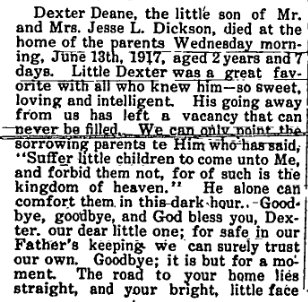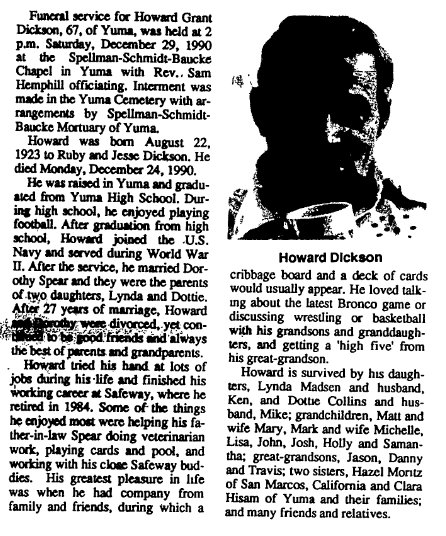Ruby Woodward Page
She was born near Newark, Kearney County, Nebraska, on April 7, 1893. In affidavits for her mother's widow pension, Joanna B. Johnson and Nancy Herring stated that they had assisted Phebe in Ruby's birth. Ruby graduated from the eighth grade, along with Wilbur Chrismer, Harry Stephens, and Bly Triplett, according to the Pioneer article of July 23, 1909.
Ruby lived with her mother Jennie Woodward in Yuma, attending school there.
In May 1911 the Akron Colorado newspaper reported on a wedding of D.P. Alexander and Miss Ollie Ward, daughter of Mrs. Drucilla Ward of Cherry Wood ranch, nine miles north of Otis.
"After partaking of the splendid spread all retired to the spacious parlor and then followed choice and inspiring music and singing rendered by Miss Dunton, the bride, Miss Ruby Woodward of Yuma, Miss Guidotta Muntzing and Mr. Muntzing"
August 3, 1959 
From the Yuma, Colorado Pioneer - March 22, 2001 [brackets are added information]
IT'S YOUR MUSEUM
by Doris Mekelburg
The following story was given to me by Ben Dickson. Jess Dickson, who told the story was Ben's uncle and the father of Clara Hisam [Mrs. Eugene Hisam].
Jess, born in July of 1881, was the oldest of five children. His father, Matthew Dickson, was born and grew up in New Jersey. Matthew's father, a Union Soldier, was killed in the Civil War, so Matt, his brother and two sisters were raised by their mother.
Matt met and fell in love with a young lady by the name of Indiana Harmon. Indiana's father, a Confederate soldier, was also killed in the Civil War. Matt and Indiana were married in Switzerland County, Indiana and later moved to Illinois where two of their children, Jess and Myrtle, were born. Matt came to eastern Colorado on Christmas Eve 1886 and filed a pre-emption claim on land seven miles northeast of Yuma. [This was about half-way to the land where Ruby's older brother Francis (Frank) Woodward and older sister Cynthia Ann Woodward filed] Three more children, Maude, Lester, and Benjamin, were born in Colorado.
According to a granddaughter, Indiana's family did not want her to move to Colorado. They thought it was nothing but a wilderness with Indians. When she came here anyway they never wrote to her or contacted her again.
As a young man, Jess worked as a cowboy and ranch hand. After his marriage to Ruby Woodward he ran a dray business. That meant he met the train with his team and wagon and hauled the sample cases, etc. of the drummers (salesmen) to the various stores so they could show their wares. He also unloaded flour, sugar and other groceries that arrived on the train and hauled them to the stores or where ever they needed to go.
When trucks were invented and came into the area, he quit the dray business and worked at the Red and White store and later for Mustains. [both were grocery stores - Mustain's still in business in Yuma]
Jess was one of the first firemen and was a charter member of the Yuma Volunteer Fire Department.
He and Ruby were the parents of four children, Dexter, (who died as an infant), Howard, Hazel and Clara. [in the 1950's Jess and Ruby worked at a creamery on Railroad Street just east of Main. They lived on North Main, on the east side directly across from the fairground road]
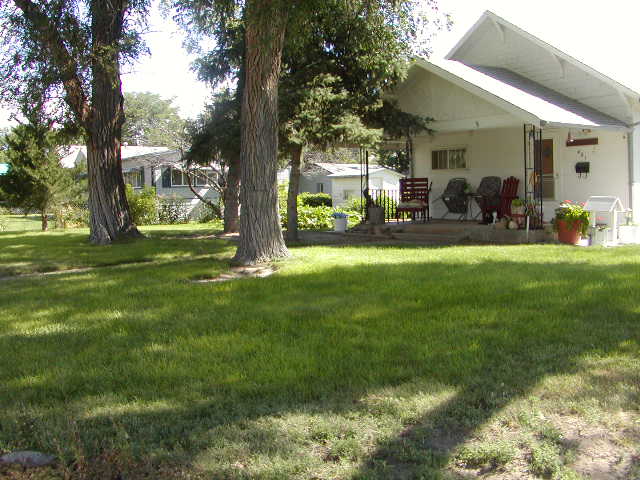 This is that house in 2011.
This is that house in 2011.

Ruby with brother Frank Woodward and his wife Alice
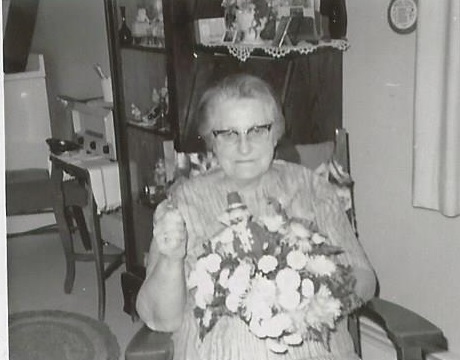
Ruby
Prior to that they lived on West Hoag (in the 700 block, it's said).
Ruby at a 1951 Memorial Day picnic in Yuma 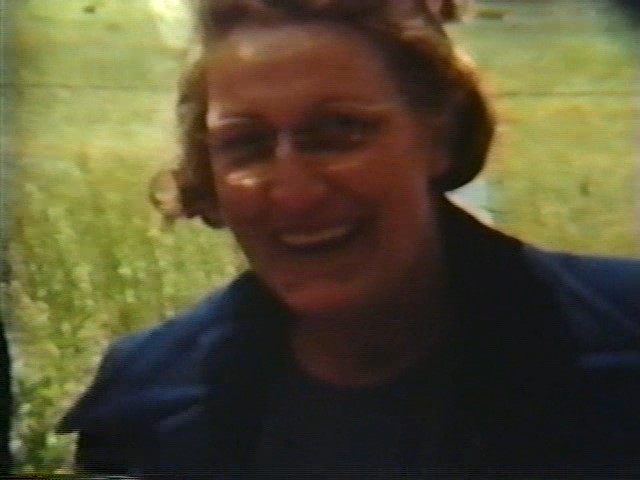
Ruby is buried in Yuma # 48944634, 1893-1981
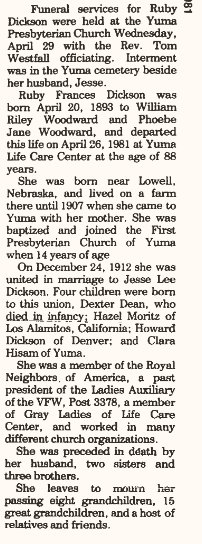
This is a story Jess told, of when he was working as a cowboy. Winters back in those earlier days were much more severe than they are today although some men might disagree after this winter.
In the spring of 1909 Jess Dickson was employed on the Kilpatrick Ranch about eight miles south of Otis.
A storm came up and he went out in an attempt to round up cattle lest they drift away in the blizzard. Difficulty was encountered because the cattle refused to face the storm to go in a homeward direction.
While he was working with the cattle in confusion he met another herder with cattle, also having difficulty. In their dilemma other men appeared with cattle until there were ten or twelve men and 3500 to 4000 cattle. All were herders and cattle from different outfits.
The group of men decided to stay with the cattle. Since it was impossible to control the direction of the cattle, the herders agreed to keep them together in their drifting.
The herd drifted almost to the South Platte River, depending on the direction of the storm. At one time they were near Merino, back to Pinneo, and other locations, always yielding to the drive of the weather.
At the approach of night some of thee herders found shelter at the homes of settlers while the rest of them kept on the trail of the herd. The next day those who slept would follow the tracks of the herd and join the group. The next night others would find shelter at some homesteader's dwelling. The settlers charged dearly for the meager accommodations offered, but the herders felt obliged to pay the charges.
It was necessary to guard the hay and feed stacks of the settlers as the large herd of cattle were hungry and almost beyond control in the sight of feed. Roughage could not be purchased from the farmers as they barely had enough feed for their own stock. And a herd of nearly 4000 would soon have left them devoid of all feed fit for consumption.
The snow was deep and crusted and quite hard. As the cattle walked, their feet would go through the snow which would cut their legs, leaving a trail of blood. The blizzard abated several times and the cattle tried to feed on the scant grass that appeared above the snow.
This struggle with the elements lasted about three weeks and some of the men taking part were Jess Dickson, Pat Sullivan, Walt Thompson and Henry Pundt. Memory of the first mentioned man did not recall the names of the rest of them.
The Kilpatrick Ranch lost about 100 of their 1000 cattle during this period while the mortality of those belonging to Jack Marley was about 1000 dead out of approximately 3000 head.
The animals and men adrift in this trek were from several different outfits.
(1951)
